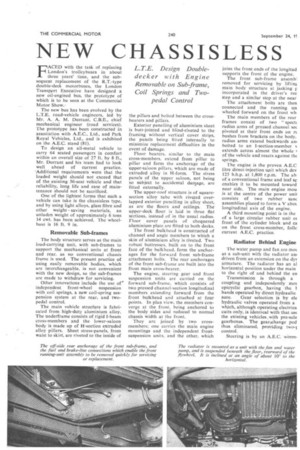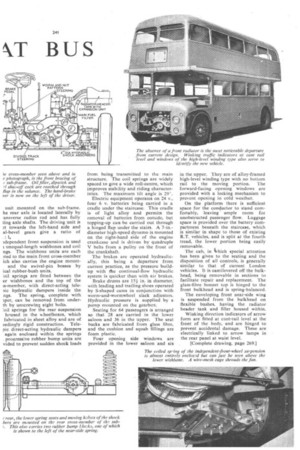NEW CHASSISLESS kT BUS
Page 94

Page 95

If you've noticed an error in this article please click here to report it so we can fix it.
L.T.E. Design Doubledecker with Engine Removable on Sub-frame, Coil Springs and Two pedal Control
FACED with the task of replacing London's trolleybuscs in about three years' time, and the subsequent replacement of the R.T.-type double-deck motorbuses, the London Transpprt Executive have designed a new oil-engined bus, the prototype of which is to be seen at the Commercial Motor Show.•
The new bus has been evolved by the L.T.E. road-vehicle engineers, led by Mr. A. A. M. Durrant, C.B.E., chief mechanical engineer (road services). The prototype has been constructed in association with A.E.C., Ltd., and Park Royal Vehicles, Ltd., and is exhibited on the A.E.C. stand (Si).
To design an all-metal vehicle to carry 64 seated passengers in comfort within an overall size of 27 ft. by 8 ft,
Mr. Durrant and his team had to look well ahead of current practice. -Additional requirements were that the loaded weight should not exceed that
of the existing 56-seat vehicle and that reliability, long life and ease of maintenance should not be sacrificed.
One of the lightest forms that such a vehicle can take is the chassisless type, and by using light alloys, glass fibre and other weight saving materials, an unladen weight of approximately 6 tons 14 cwt. has been achieved. The wheelbase is 16 ft. 9 in.
Removable Sub-frames
The body structure serves as the main load-carrying unit, with sub-frames to support the mechanical units at front and rear, as no conventional chassis frame is used. The present practice of using easily removable bodies, which are interchangeable, is not convenient with the new design, so the sub-frames are made to withdraw for servicing.
Other innovations include the use of independent front-wheel suspension with coil springs, a new coil-spring suspension system at the rear, and twopedal control.
The main vehicle structure is fabricated from high-duty aluminium alloy. The underframe consists of rigid I-beam cross-members and the lower-saloon body is made up of H-section extruded alloy pillars. Sheet stress-panels, from waist to skirt, are riveted to the inside of the pillars and bolted between the crossbearers and pillars.
Exterior panelling of aluminium sheet is butt-jointed and blind-riveted to the framing without vertical cover strips, the panels being fitted internally to minimize replacement difficulties in the event of damage.
Floor bearers, similar to the main cross-members, extend from pillar to pillar and form the anchorage of the upper-saloon pillars, which are made of extruded alloy in H-form. The stress panels of the upper saloon, not being so subject to accidental darriage, are fitted externally.
The upper-roof structure is of squaresection alloy tube with rived overlapped exterior panelling in alloy sheet, as are the floors and ceilings. The upper-deck floor is laid in three fiat sections, instead of in the usual radius. Floor cover panels of chequered aluminium plate are fitted to both decks.
The front bulkhead is constructed of channel and angle members to which a skin of aluminium alloy is riveted. Two robust buttresses, built on to the front face of the bulkhead, form the anchorages for the forward front sub-frame attachment bolts. The rear anchorages of the front sub-frame are built into the front main cross-bearer.
The engine, steering gear and front suspension units are carried on the forward sub-frame, which consists of two pressed channel-section longitudinal members extending forward from the front bulkhead and attached at four points. In plan view, the members converge at the front, being anchored to the body sides and reduced to normal chassis width at the front.
They are joined by two crossmembers; one carries the main engine mountings and the independent frontsuspension units, and the other. which joins the front ends of the longitud supports the front of the engine.
The front sub-frame assembl removed for servicing by liftiN main body structure at jacking p incorporated in the driver's rec step and a similar step at the near The attachment bolts are then connected and the running un wheeled forward on the front wh.
The main members of the rear frames consist of two " spectz radius arms of pressed channel sec pivoted at their front ends on rt. bushes from brackets on the body. radius arms extend backwards an' bolted to an I-section-member extends across almost the whole of the vehicle and reacts against thc springs.
The engine is the proven A.E.0 litre direct-injection unit which dev 125 b.h.p. at 1,800 r.p.m. The ab: of a conventional frame and leaf sp enables it to be mounted toward near side. The main engine mou is at the centre of the power unit consists of two rubber sanc assemblies placed to form a V abot longitudinal axis of the engine.
A third mounting point is in the of a large circular rubber unit en front of the cylinder block and ca on the front cross-member, folic current A.E.C. practice.
Radiator Behind Engine
The water pump and fan are mot as a sub-unit with the radiator an' driven from an extension on the dyr armature. The radiator has an al horizontal position under the main to the right of and behind the en Transmission is through a coupling and independently mot epicyclic gearbox, having the t bands operated by direct hydraulic
sure. Gear selection is by ele hydraulic valves operated from a which, although operating electrica cults only, is identical with that usc the existing vehicles. with pre-sele gearboxes. The gearhange ped thus eliminated, providing two-1 control.
Steering is by an A.E.C. worm
unit mounted on the sub-frame. he rear axle is located laterally by .ansverse radius rod and has fully Ling axle shafts. The driving unit is :t towards the left-hand side and al-bevel gears give a ratio of :
idepenclent front suspension is used unequal-length wishbones and coil ngs. The wishbone units are each )ted to the main front cross-member ich also carries the engine mount and the swivel-pin bosses by ical rubber-bush units.
:oil springs are fitted between the er wishbones and the top of the is-member, with direct-acting telelie hydraulic dampers inside the ngs. The spring, complete with iper, can be removed from underth by unscrewing eight bolts.
:oil springs for the rear suspension housed in the wheelboxes, which fabricated in sheet alloy and are of eedingly rigid construction. Telepic direct-acting hydraulic dampers again enclosed within the springs . progressive rubber bump units are vided to prevent sudden shock loads from being transmitted to the main structure. The coil springs are widely spaced to give a wide roll-centre, which improves stability and riding characteristics. The maximum tilt angle is 29'.
Electric equipment operates on 24 v., four 6 v. batteries being carried in a cradle under the staircase. This cradle is of light alloy and permits the removal of batteries from outside, but topping-up can be carried out through a hinged flap under the stairs. A 7-in.diameter high-speed dynamo is mounted on the right-hand side of the engine crankcase and is driven by quadruple V belts from a pulley on the front of the crankshaft.
The brakes are operated hydraulically, this being a departure from current practice, as the pressure buildup with fie continual-flow hydraulic system is quicker than with air brakes.
Brake drums are 151 in. in diameter; with leading and trailing shoes operated by S-shaped cams in conjunction with worm-and-wormwheel slack adjusters. Hydraulic pressure is supplied by a pump mounted on the gearbox.
Seating for 64 passengers is arranged so that 28 are carried in the lower saloon and 36 in the upper. The seat backs are fabricated from glass fibre. and the cushion and squab fillings are foam plastic.
Four opening side windows are provided in the lower saloon and six in the upper. They are of alloy-framed high-level winding type with no bottom rail to the moving portion. The forward-facing opening windows are provided with a locking mechanism to prevent opening in cold weather.
On the platform there is sufficient space for the conductor to stand comfortably, leaving ample room for unobstructed passenger flow. Luggage space is provided over the battery compartment beneath the staircase, which is similar in shape to those of existing R.T. vehicles, and is split at the fourth tread, the lower portion being easily removable.
The cab, in thich special attention has been given to the seating and the disposition of all controls, is generally similar to that of current London vehicles. It is cantilevered off the bulkhead, being removable in sections to facilitate repair and replacement. The glass-fibre bonnet top is hinged to the front bulkhead and is spring-balanced.
The enveloping front near-side wing is suspended from the bulkhead on flexible bushes, having the radiator header tank and filler housed within.
Winking direction indicators of arrow form are fitted at cant-rail level at the front of the body, and are hinged to prevent accidental damage. These are electrically linked to arrow lamps in the rear panel at waist 'level.
[Complete drawing, page 269.]
























































































































































































































































































































